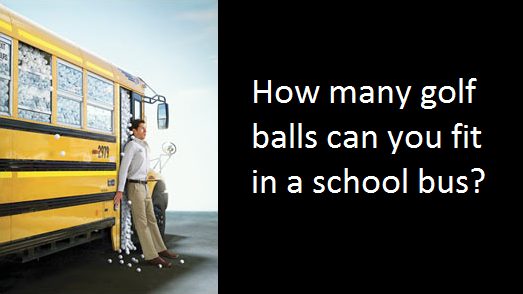
Week 3 of the #MTBoS blogging challenge is all about questioning. Here’s a favourite brand of question I use in my classes a lot. The Numberless Question.
Google is apparently the best place in the world to work, and the competition to work there is fierce. They are also famous for some very strange questions in their interviews. Consider this question…

That’s it, no numbers, no dimensions and you’re not allowed to “google it”(gasp)
I love this question because it more closely mirrors the mathematics real people do. It turns maths into a creative process, where the first step is figuring out what you need to know and how to find it.
It’s also an exciting way to show students that mathematics is about process, not answers. In a question like this, process is everything, since there is no “The Answer”. A student’s justification and process is all that matters. Too often, students race to “The Answer”. I find playing with questions like this allows students to explore maths more deeply.
Numberless questions are also easily differentiated. Should we account for the seats, or should we remove them? Should we consider the golf balls as spheres or cubes, since an estimate might be good enough. If we’re assuming spheres, should we consider the space in between the spheres? How big is that space?
How about some other ones?




So try leaving the numbers out some time. Because, as with pizza toppings, sometimes less is more.
Love it. I’ve asked the question of whether you could fit “a million balls” in your classroom from the idea I found at http://www.help4teachers.com/SandyOneMillionBalls.html Excellent discussions in class! But I like your idea to present the problem with a photograph even better.
These questions force students to be creative thinkers in math class – and if they are compelling enough (as each of your examples are), everyone wants to know the answer! I have found that some students are very uncomfortable with this kind of task – especially those that have had success with more standard problem sets.
Thanks for these. Got any more to share?
I love these types of questions and some of yours are so fun! Makes me think of two things: 1. Estimation 180 (http://www.estimation180.com) and 2. Wits and Wagers (http://www.boardgamegeek.com/boardgame/20100/wits-wagers). But I didn’t know that this was the type of question Google asks to see how their job candidates reason through something they would very likely have NO experience in. Sometimes I think my students think I just pose these questions for fun, but in fact they’d be interested to know that the best companies in the world are looking for people who can think not just solve.
I hadn’t seen estimation180 before and it looks great. I’m definitely buying that boardgame too, it looks like a lot of nerdy fun.
This is thought-provoking. The math nerd in me is really wanting some numbers though! My students would love it I’m sure!!
Hi Teri. I actually find that the first time my students try these type of questions they are really unsure about it. They’ve always had a definite answer to aim for, so this is something way out of their comfort zone.
I enjoy seeing the “math nerds” struggle with this idea.
Interesting and amazing how your post is! It Is Useful and helpful for me That I like it very much, and I am looking forward to Hearing from your next..